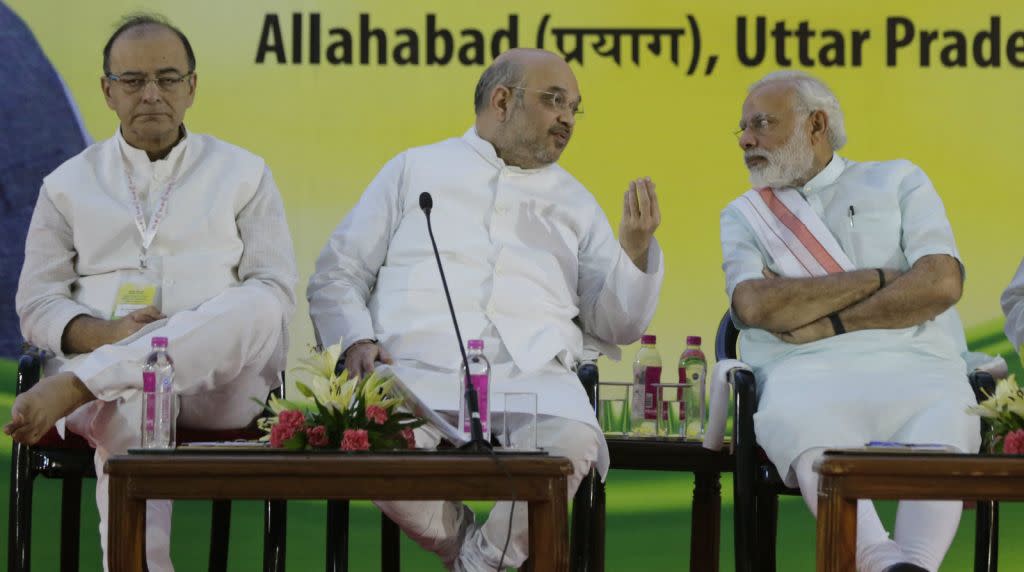The rise of the “illiberal elite” in India and America

Were Argentine short-story writer Jorge Luis Borges alive, and had he followed the surreal discourse marking Indian and American politics over the last couple of years or so, he would have promptly published an updated version of his endlessly fascinating work, The Book of Imaginary Beings. To his collection of marvellous and strange beasts engendered by the human imagination curated in the text, Borges would have added another mythic creature, “the liberal elite.”
Everyone should read this great article in Boston magazine! pic.twitter.com/CcWJcZ6T51
— PoliticallyIncorrect (@Dont_PCMe) January 4, 2017
The abstraction of the “liberal elite” represents that Archimedean point where liberal self-flagellation and conservative triumphalism meet. Shell-shocked by Donald Trump’s election victory, American commentators across the political spectrum put the blame for this on myopic, out-of-touch liberal elites, lost in their fog of Pinot Noir fumes as they seek to change the world from the hipster enclaves of Brooklyn and the hilltops of San Francisco. Liberal elites have been blamed for foisting a culture of political correctness that has run berserk. This culture is said to be marked by an indifference to the travails of white working class folk, especially in middle America, by a refusal to call a Muslim terrorist spade a spade.
An #AdarshLiberal family is well settled and earning good money #BecauseOfNehru pic.twitter.com/Mc8Vgopw8F
— Adarsh Liberal (@AdarshLiberal) March 15, 2015
In India, Narendra Modi’s election victory in 2014 and subsequent policies have likewise been hailed as a ringing endorsement of his son-of-the-soil charisma by his admirers, fence-sitters who voted for “development,” and even staunch self-professed liberals tired of an enervated Congress Party and ineffectual secularism. Somewhat mystifyingly, commentators with impeccable elite credentials, like the writer Aatish Taseer and columnists Swapan Dasgupta and Ashok Malik, have described Modi’s ascendancy as heralding the twilight of Nehruvian elites in Lutyens’ Delhi.
#AdarshLiberals started building alternate narrative calling terrorists in Student Islamic Movement of India as "Prisoners with No Guns" pic.twitter.com/n8R9VjX1H3
— Sickcular Fiberal (@SickularLibtard) October 31, 2016
Such elite voices for subaltern political sentiment see the new Indian prime minister as the messiah of the organic, grassroots-level authentic Indians ready to stake their claim on the country. In a recent essay defending Modi’s welfarist populism, Malik coined the charming phrase “Khan Market consensus,” painting Modi, by contrast, as a great dissenter against Delhi’s hegemonic cultural, social, and political elites. Although not used as much as in the US, political correctness has been berated in India, too, since 2014: it is held responsible for the appeasement of Muslims, reservations for Dalits, and the imposition of an alien anti-Hindu secularism in school syllabi and public space, all of which are said to have cost India dearly.
"Political correctness is tyrany with manners" ~Charlton Heston#DrainTheSwamp pic.twitter.com/Oqw8Q2mQuQ
— Zvi Lando (@zlando) December 30, 2016
Lazy scapegoating
While liberal worldviews, philosophies, and ideologies should be subjected to critique—as they amply are, actually—the lazy scapegoating of the “political correctness” of the Indian or American liberally-inclined elite is riddled with contradictions. Indeed, it serves the ideological function of defending and perpetuating the very injustices that a liberal politics is meant to redress. One common grouse against the elitist liberal worldview is that it focuses disproportionately on identity politics, privileging the difficulties faced by racial, ethnic, and sexual minorities over those faced by the majorities, and ignoring class and economic issues. Yet, interpreting the resurgence of the Hindu and white right as an inevitable correction of such overreach ignores the fact that the natural order supposedly being restored takes the majoritarian caste Hindu and white experience as the invisible, assumed norm.
George HW Bush, a Conservative, in 1998 famously declared class as something that existed in European societies but not in America. The same Bush, incidentally, had no idea how to navigate a supermarket where ordinary Americans shopped for groceries. It is American conservatives who have called for shrinking social welfare programmes, which, ironically, stand to benefit large numbers of citizens from the poorer sections of red states.
In the Indian context, it was the Modi government and its bureaucrats that sought to roll back the welfarist programs of the earlier United Progressive Alliance government. Since then, the National Democratic Alliance (NDA) government has suitably been chastened, learning that doing away with these popular programs would risk serious loss of political capital. It has sought to defend this position through the convoluted and comical justification that its welfarist policies are more merit-driven than those of its predecessor. These measures, ironically, are among the few NDA initiatives that do not overtly or covertly invoke cynical identity politics, in contrast to the theatrics over implementing a Uniform Civil Code or recent noises over banning beef, for example.
Political Correctness in one cartoon. via @washingtonpost pic.twitter.com/JDP8hAmDEi
— teresa bücker (@fraeulein_tessa) January 1, 2017
Deeper questions
In both India and the US, what we have witnessed is the rise of illiberal elites or, rather, their victory in social, cultural, and political space. The tacit agreement between the Left and Right in designating their liberal counterparts as the primary factor underlying their newfound prominence deflects attention from the social, economic, cultural, and political dynamics that have led to this state of affairs.
This mix includes a radically changed political economy of global labour, a perceived inadequacy of states to address the challenges of globalisation, diminishing appeal of the liberal and Left projects, risk and insecurity becoming part of everyday life, and the limited affective pull of cosmopolitanism as compared to the utopian promise of the local.
In seeking to understand the interplay of these trends and how they have produced our current political reality, we would do well to listen to liberals, including those of the elitist variety.
This post first appeared on Scroll.in. We welcome your comments at ideas.india@qz.com.

Sign up for the Quartz Daily Brief, our free daily newsletter with the world’s most important and interesting news.
More stories from Quartz:
